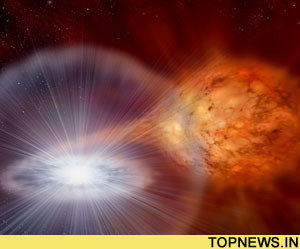Giant star may be used to measure distances up to 300 million light years and beyond
 Washington, June 9 : Scientists from Ohio State University have found a way to measure distances to objects three times farther away in outer space than previously possible, by discovering that a rare type of giant star could make an excellent signpost for distances up to 300 million light years and beyond.
Washington, June 9 : Scientists from Ohio State University have found a way to measure distances to objects three times farther away in outer space than previously possible, by discovering that a rare type of giant star could make an excellent signpost for distances up to 300 million light years and beyond.
Cepheid variables, which are giant stars that pulse in brightness, have long been used as reference points for measuring distances in the nearby universe, according to Jonathan Bird, doctoral student in astronomy at Ohio State.
Classical cepheids are bright, but beyond 100 million light years from Earth, their signal gets lost among other bright stars.
Astronomers have also long suspected that ULP cepheids don't evolve the same way as other cepheids.
In this study, however, the Ohio State team found the first evidence of a ULP cepheid evolving as a more classical cepheid does.
Bird revealed that a rare and even brighter class of cepheid - one that pulses very slowly - can potentially be used as a beacon to measure distances three times farther than their classical counterparts.
Krzysztof Stanek, professor of astronomy at Ohio State, applied a direct measurement technique in 2006, when he used the light emerging from a binary star system in the galaxy M33 to measure the distance to that galaxy for the first time.
This new technique using so-called "ultra long period cepheids" (ULP cepheids) could work for galaxies that are much farther away than M33.
"We found ultra long period cepheids to be a potentially powerful distance indicator. We believe they could provide the first direct stellar distance measurements to galaxies in the range of 150 million - 326 million light years and well beyond that," Stanek said.
Because researchers generally don't take note of ultra long period cepheids, there are few of them in the astronomical record.
For this study, Stanek, Bird and Ohio State doctoral student Jose Prieto uncovered 18 ULP cepheids from the literature.
Each was located in a nearby galaxy, such as the Small Magellanic Cloud.
The distances to these nearby galaxies are well known, so the astronomers used that knowledge to calibrate the distance to the ULP cepheids.
They found that they could use ULP cepheids to determine distance with a 10-20 percent error - a rate typical of other methods that make up the cosmic distance ladder.
"We hope to reduce that error as more people take note of ULP cepheids in their stellar surveys," Bird said. "What we've shown so far is that the method works in principle, and the results are encouraging," he added. (ANI)